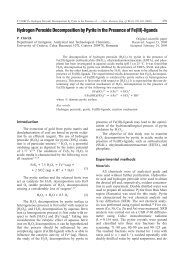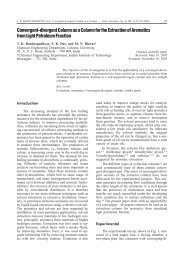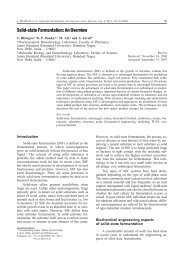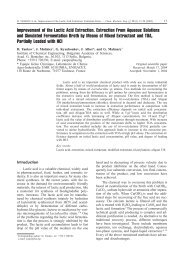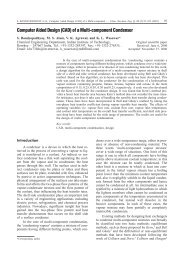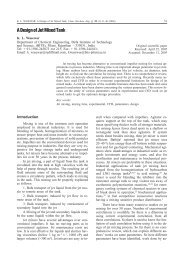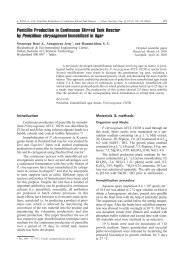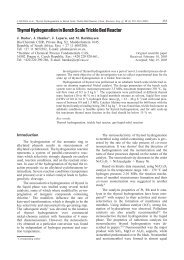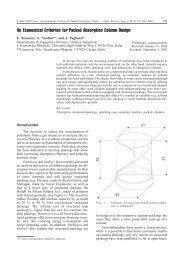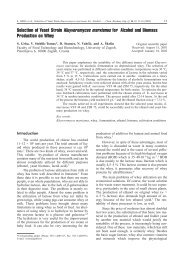Modular-Based Modelling of Protein Synthesis Regulation
Modular-Based Modelling of Protein Synthesis Regulation
Modular-Based Modelling of Protein Synthesis Regulation
You also want an ePaper? Increase the reach of your titles
YUMPU automatically turns print PDFs into web optimized ePapers that Google loves.
224 G. MARIA, <strong>Modular</strong>-<strong>Based</strong> <strong>Modelling</strong> <strong>of</strong> <strong>Protein</strong> <strong>Synthesis</strong> <strong>Regulation</strong>, Chem. Biochem. Eng. Q. 19 (3) 213–233 (2005)<br />
proteins interact over the parallel/consecutive metabolic<br />
path. In spite <strong>of</strong> an apparent ‘competition’ for<br />
nutrient consumption, protein synthesis is a closely<br />
cooperative process, due to the specific role and<br />
function <strong>of</strong> each protein inside the cell. 3,12 <strong>Protein</strong><br />
interactions are very complex, being part <strong>of</strong> the cell<br />
metabolism and distributed over regulatory network<br />
nodes. There are many nodes with few connections<br />
among proteins and a small, but still significant,<br />
number <strong>of</strong> nodes with many proteic interactions. 4<br />
These highly connected nodes tend to be essential<br />
to an organism and to evolve relatively slowly. At a<br />
higher level, protein interactions can be organised<br />
in ‘functional modules’, which reflect sets <strong>of</strong> highly<br />
interconnected proteins ensuring certain cell functions.<br />
Specific proteins are involved in nutrient permeation<br />
(permeases), in metabolite synthesis<br />
(metabolases), or in gene production (polymerases).<br />
In general, experimental techniques can point-out<br />
molecular functions <strong>of</strong> a large number <strong>of</strong> proteins,<br />
and can identify functional partners over the metabolic<br />
pathways. Moreover, protein associations can<br />
ensure supplementary cell functions. For instance,<br />
enzyme associations lead to the well-known ‘metabolic<br />
channelling’ (or tunnelling) process, that ensures<br />
an efficient intermediate transfer and metabolite<br />
consecutive transformation without any<br />
release into the cell bulk phase. 87<br />
It results that an effective module linking strategy<br />
has to ensure the cell-functions <strong>of</strong> individual<br />
proteins and <strong>of</strong> protein associations over the metabolic<br />
synthesis network. As a general observation,<br />
even not presenting common reactions, the modules<br />
are anyway linked through the cell volume (to<br />
which all cell species contribute) and due to some<br />
signalling intermediates controlling the regulatory<br />
network construction. The variable cell-volume<br />
model is able to account for such cell regulatory<br />
characteristics. From the theoretical point <strong>of</strong> view,<br />
several linking alternatives can be investigated,<br />
such as cooperative vs. uncooperative linking. In a<br />
cooperative linking, common species (or reactions)<br />
are used for a cross-control (or cross-catalysis) <strong>of</strong><br />
the synthesis reactions. Thus, the system stability is<br />
strengthened, while species inter-connectivity is increased<br />
leading to a better treatment <strong>of</strong> perturbations.<br />
Step-by-step building-up <strong>of</strong> a regulatory<br />
modular structure – An example<br />
The present study aims to exemplify, at a generic<br />
level and by using the variable cell-volume<br />
model, various alternatives to link regulatory modules,<br />
and to simulate protein interrelations during<br />
metabolic synthesis. It also investigates the feasibility<br />
<strong>of</strong> a module linking strategy to elaborate a regulatory<br />
network, and the way in which a step-by-step<br />
increase in the network complexity is reflected by<br />
the regulatory efficiency <strong>of</strong> the whole path.<br />
To exemplify such an analysis in a simple way,<br />
one considers a hypothetical cell, similar to E. coli,<br />
in an equilibrated growth at a constant temperature,<br />
with a cell cycle period <strong>of</strong> t c = 100 min, and a<br />
quasi-constant logarithmic growing rate <strong>of</strong> D s =<br />
ln(2)/t c . Concentrations <strong>of</strong> lumped nutrients in the<br />
environment have been considered constant, i.e.<br />
c NutG,s = 3×10 6 nmol L –1 , c NutP,s = 3×10 8 nmol L –1<br />
(similarly to Morgan et al. 56 ). As only a few number<br />
<strong>of</strong> individual species are accounted in the<br />
model, the cell ‘ballast’ is mimicked by adopting<br />
high levels for metabolite concentrations, i.e.<br />
c = 3×10 8 nmol L –1 ; c c<br />
<br />
j<br />
c<br />
MetPj<br />
, s<br />
NutP s<br />
cell<br />
<br />
j<br />
MetG<br />
NutG s<br />
j, s ,<br />
, c j s 10 6 n mol L –1 . For the genes,<br />
jMetG<br />
j<br />
proteins, and other intermediates, the stationary<br />
concentrations are displayed in the footnote <strong>of</strong> Table<br />
1. Species in the environment have been<br />
lumped, and only two groups (NutP and NutG)<br />
have been considered. Not to complicate the model,<br />
only protein concentration diminishment due to the<br />
cell-growth dilution effect has been considered, the<br />
protein degradation being neglected. Once the network<br />
construction methodology elaborated, more<br />
detailed modular representations can include mechanism<br />
extensions in the analysis.<br />
The network construction starts with considering<br />
the simplest system, i.e. a cell which includes<br />
only one module for P-protein synthesis, in an unregulated<br />
alternative G(P)0. In such a simplified<br />
representation, a simple reaction, catalysed by P, is<br />
used to kinetically describe the membrane permeation<br />
and nutrient transformation into metabolites<br />
(see Fig. 3). The considered stationary concentrations<br />
for the P/G pair are c Ps = 1000 nmol L –1 and<br />
c Gs = 1 nmol L –1 . The value <strong>of</strong> 1 nmol L –1 for gene<br />
concentration in a newborn cell results from applying<br />
the formula: 56<br />
concentration =<br />
no. <strong>of</strong> copies / cell<br />
(10)<br />
N V ,0<br />
(where N A is the Avogadro number). As for an E.<br />
coli cell, with an approximate V cyt,0 = 1.66 × 10 –15 L<br />
(see Yang et al. 5 ), it results for c Gs a value <strong>of</strong><br />
1/(6.022 × 10 23 )(1.66 × 10 –15 ) = 1 nmol L –1 (i.e.<br />
10 –9 mol L –1 ). The other species <strong>of</strong> the cell are included<br />
in the cell ‘ballast’ by adopting high levels<br />
for metabolites (~10 8 n mol L –1 ). Then, the module<br />
is improved by adding a regulatory element. For instance,<br />
by including a simple effector and a buffering<br />
reaction, one obtains the module G(P)1 (Fig. 2<br />
and Fig. 3, c Gs = c GPs = 1 2 nmol L –1 ). Rate constants<br />
are then estimated from the QSS condition (6).<br />
A<br />
cyt



